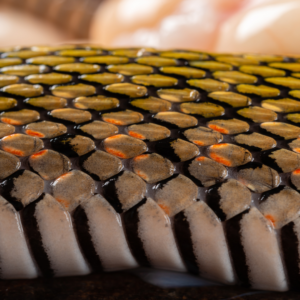We use affiliate links to run our site. When you buy through links on our site, we may earn an affiliate commission, without any added cost to you. Learn more
Have you ever wondered if snakes have bones? These mesmerizing creatures have captivated human fascination for centuries, with their sleek bodies, stealthy movements, and unique ability to swallow prey whole.
In this article, we will delve into the intriguing world of snake anatomy and answer the burning question: Do snakes have bones? Prepare to be amazed as we unravel the mysteries of these enigmatic reptiles.
What Are Snakes Made Of?
To understand whether snakes have bones, we must first explore the composition of their bodies. Snakes, like all reptiles, have a vertebrate structure, which means they possess a backbone. However, their skeletal system differs significantly from that of mammals, including humans.
The Skeleton of a Snake: Unique Adaptations
While snakes have a backbone, they don’t possess the typical skeletal structure with a multitude of individual bones that we commonly associate with mammals. Instead, their skeleton is highly specialized and adapted to suit their unique way of life.
Snakes belong to a group of reptiles called “squamates,” which also include lizards and amphisbaenians. These reptiles have elongated bodies and are known for their remarkable flexibility. To accommodate their serpentine form, snakes have evolved a skeleton that allows for extreme agility and the ability to maneuver through tight spaces.
A list of things you probably don’t know about snakes
Adaptations in Snake Skeletons:

Snakes’ bodies are elongated, cylindrical, and lack limbs. To enable their distinctive slithering motion, snakes have undergone several fascinating adaptations. One of the most notable adaptations is their highly specialized skeletal structure.
Instead of a traditional skeleton consisting of numerous bones, snakes possess a streamlined and flexible framework. Their skeletons primarily consist of three main components: a skull, a series of vertebrae, and ribs.
Types of BonesFound in Snakes:
Like all vertebrates, snakes possess bones that provide structural support and protection for their bodies. However, the composition and arrangement of bones in snakes differ from those of other animals. Snakes have a unique bone structure that enhances their slithering abilities.
Snakes primarily possess two types of bones: solid bones and hollow bones. Solid bones, also known as compact bones, are dense and provide strength and rigidity to certain parts of the snake’s body, such as the skull and vertebrae.
On the other hand, hollow bones also referred to as pneumatic bones, are characterized by air-filled spaces within them. These bones are lighter, contributing to the overall agility and maneuverability of the snake.
The distribution of solid and hollow bones throughout a snake’s body varies depending on the species and their specific adaptations.
While some bones remain predominantly solid, others exhibit a combination of both solid and hollow components, allowing for a delicate balance between strength and flexibility.
Shedding Light on Snake Bones
So, while snakes do have a skeletal structure, it is vastly different from what we traditionally associate with bones. The snake’s skeleton is elongated, flexible, and highly adapted for its unique lifestyle.
Instead of a rigid framework of interconnected bones, a snake’s skeleton consists of numerous individual vertebrae, loosely attached ribs, and a remarkably flexible skull.
The Anatomy of A Snake Skeleton:

The skeleton of a snake consists primarily of the following components:
a) Vertebrae
The vertebral column, or backbone, is a crucial component of any animal’s skeleton. In snakes, the backbone takes on a unique form to facilitate their extraordinary movements.
Snakes possess an impressive number of vertebrae, ranging from as few as 100 to well over 400, depending on the species.
Each vertebra in a snake’s spine is connected to the next by highly flexible joints. These joints, known as zygapophyses, allow for a wide range of motion between the vertebrae.
Unlike the interlocking joints found in most mammals, snakes’ vertebrae are loosely connected, granting them exceptional flexibility and enabling their characteristic undulating motion.
b) Ribs
Snakes possess ribs just like mammals do, but their ribs serve a different purpose. In mammals, ribs are attached to the sternum and help protect vital organs such as the heart and lungs.
In snakes, however, the ribs are not connected to the sternum but are loosely attached to the vertebrae. This flexibility enables their ribcage to expand when swallowing large prey.
c) Skull & Jaws:
Snakes’ skulls are intricate structures designed to accommodate their unique feeding habits. The skull is elongated and hinged to allow the snake’s mouth to open wide, facilitating the consumption of large prey.
Unlike humans and many other animals, snakes’ jaws are not fused together. Instead, they are connected by ligaments and highly flexible joints, enabling them to stretch their mouths to astonishing proportions.
This remarkable adaptation allows snakes to swallow prey much larger than their own head size.
By dislocating their jaws and employing a series of coordinated muscle contractions, snakes can consume meals that appear seemingly impossible for their slender bodies.
Why does a snake yawn?
d) Other Adaptations
In addition to the primary skeletal components, snakes possess other remarkable adaptations. They lack limbs, which further enhances their ability to navigate through narrow crevices and undergrowth. Some species also have vestigial pelvic bones and tiny spurs, remnants of their evolutionary past when their ancestors had legs.
Function and Adaptation: The Role of Snake Bones
Snakes’ bone composition serves multiple essential functions that contribute to their survival and unique locomotion. Let’s explore the primary roles played by these remarkable skeletal elements:
1. Support and Protection
Bones in snakes fulfill a crucial role in providing structural support and protection. The solid bones, particularly in the skull and vertebral column, offer stability and safeguard the delicate organs housed within the snake’s body. These bones help maintain the structural integrity necessary for efficient movement and overall functionality.
2. Efficient Locomotion
The interplay between solid and hollow bones in snakes allows for efficient locomotion. The lightweight nature of hollow bones reduces the overall mass of the snake, making it easier to propel and maneuver swiftly.
Additionally, the flexibility provided by hollow bones contributes to the snake’s graceful slithering motion, enabling them to navigate various terrains and squeeze through tight spaces with ease.
3. Swallowing Large Prey
Snake bones, especially those in the skull and jaw, have evolved to facilitate their unique feeding habits. The highly flexible skull and loosely connected jaw bones enable snakes to consume prey much larger than their own head size.
By dislocating their jaws and employing a series of coordinated muscle contractions, snakes can engulf and digest meals that appear seemingly impossible for their slender bodies.
4. Shedding Skin
While not directly related to bone composition, it’s worth mentioning that bones play a role in the shedding process of snakes. As snakes grow, their skin becomes tight, necessitating the shedding of the old skin to accommodate their expanding bodies.
The flexibility of snake bones allows the snake to maneuver and contort, facilitating the shedding process and ensuring the successful removal of the old skin.
Common Misconceptions About Snake Bones:
Given the remarkable flexibility and agility of snakes, it’s not surprising that a common misconception has emerged—the belief that snakes are entirely boneless. However, as we have explored, snakes do possess bones, albeit in a modified and specialized form.
Snakes’ skeletons have evolved to suit their specific lifestyle and locomotion needs. Their streamlined bodies, elongated vertebrae, flexible ribs, and unique skulls all contribute to their incredible adaptability in diverse environments.
Conclusion:
So, to summarize, snakes do have bones but in a highly specialized form. Snakes have a flexible and elongated skeleton composed of individual vertebrae, loosely attached ribs, and a remarkably adaptable skull.
These unique adaptations allow snakes to move with unparalleled flexibility and devour prey larger than their own size.
So, the next time you encounter a snake and wonder about its bones, remember the intricacies of its skeletal structure. Snakes truly are wonders of evolution, beautifully designed for their remarkable existence in the animal kingdom.
I hope you found this post helpful. If you like the information don’t hesitate to share it with others also.
Amazon and the Amazon logo are trademarks of Amazon.com, Inc, or its affiliates.
